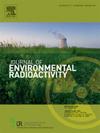使用康普顿伽马成像测量在0.5公里宽的禁区内扩展的La-140源的空间展开。
IF 1.9
3区 环境科学与生态学
Q3 ENVIRONMENTAL SCIENCES
引用次数: 0
摘要
本文介绍了利用基于硅光电倍增管的康普顿安全与安保望远镜(SCoTSS)伽马成像仪对位于500米× 500米禁区内的分布式La-140源进行周长调查时获取的室外试验数据,并应用先进的空间展开技术获得的结果。实验的合成数据版本也使用蒙特卡罗模拟和重建。对于实验数据和合成数据,该方法都忠实地再现了活动分布的形状,对于合成数据,也再现了总活动。然而,对于实验数据,该方法低估了总活度的六倍。这可以通过不包括在检测器响应函数中的环境雪和土壤条件来解释。康普顿伽马成像仪测量数据反演方法的应用证明了其在极端天气和交通限制严重影响数据采集质量的恶劣条件下的适用性。试验表明,该方法在放射性和核安全与安保领域具有广泛的适用性,特别是在威胁材料或污染区域处于禁入或禁飞区的情况下。本文章由计算机程序翻译,如有差异,请以英文原文为准。
Spatial unfolding of an extended La-140 source within a 0.5 km-wide exclusion zone using Compton gamma imaging measurements
Results from applying an advanced spatial-unfolding technique to outdoor-trial data acquired with a Silicon photomultiplier-based Compton Telescope for Safety and Security (SCoTSS) gamma imager during perimeter survey of a distributed La-140 source lying within a 500 m x 500 m exclusion zone are presented. A synthetic-data version of the experiment was also modelled using Monte Carlo simulations and reconstructed. For both experimental and synthetic data the method faithfully reproduces the shape of the activity distribution, and for synthetic data the total activity is reproduced as well. However, for the experimental data the method underestimates the total activity by a factor of six. This can be accounted for by environmental snow and soil conditions not included in the detector response functions. This application of the Compton gamma imager survey-data inversion method demonstrates its applicability under austere conditions wherein extreme weather and transportation constraints severely impacted the quality of the data collected. The trial shows that the method has widespread applicability in the radiological and nuclear safety and security field, particularly for scenarios in which a threat material or contaminated area lies within a no-entry or no-fly zone.
求助全文
通过发布文献求助,成功后即可免费获取论文全文。
去求助
来源期刊

Journal of environmental radioactivity
环境科学-环境科学
CiteScore
4.70
自引率
13.00%
发文量
209
审稿时长
73 days
期刊介绍:
The Journal of Environmental Radioactivity provides a coherent international forum for publication of original research or review papers on any aspect of the occurrence of radioactivity in natural systems.
Relevant subject areas range from applications of environmental radionuclides as mechanistic or timescale tracers of natural processes to assessments of the radioecological or radiological effects of ambient radioactivity. Papers deal with naturally occurring nuclides or with those created and released by man through nuclear weapons manufacture and testing, energy production, fuel-cycle technology, etc. Reports on radioactivity in the oceans, sediments, rivers, lakes, groundwaters, soils, atmosphere and all divisions of the biosphere are welcomed, but these should not simply be of a monitoring nature unless the data are particularly innovative.
 求助内容:
求助内容: 应助结果提醒方式:
应助结果提醒方式:


